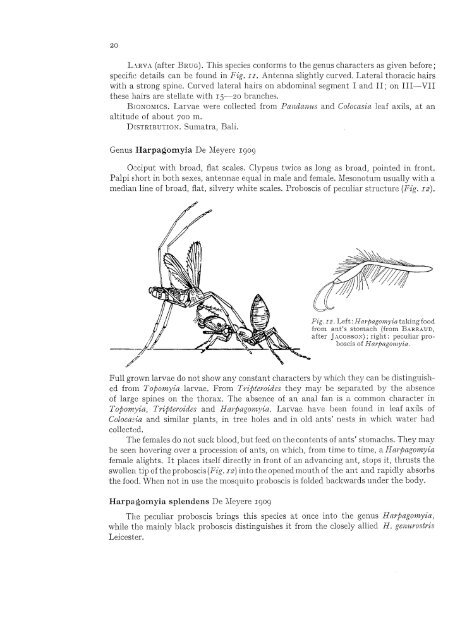Synopsis of a hundred common non-anopheline mosquitoes of the ...
Synopsis of a hundred common non-anopheline mosquitoes of the ...
Synopsis of a hundred common non-anopheline mosquitoes of the ...
You also want an ePaper? Increase the reach of your titles
YUMPU automatically turns print PDFs into web optimized ePapers that Google loves.
20<br />
LARVA (after BRUG). This species conforms to <strong>the</strong> genus characters as given before;<br />
specific details can be found in I;i,. g II. Antenna slightly curved. Lateral thoracic hairs<br />
with a strong spine, Curved lateral hairs on abdominal segment I and II; on III--VII<br />
<strong>the</strong>se hairs are stellate with 15-20 branches.<br />
B~ONOMICS. Larvae were collected from Pn~z&znus and Colocnsin leaf ax&, at an<br />
altitude <strong>of</strong> about 700 m.<br />
DETRIBUTIOX. Sumatra, Bali.<br />
Genus Harpagomyia De Aleyere agog<br />
Occiput with broad, flat scales. Clypeus twice as long as broad, pointed in front.<br />
Palpi short in both sexes, antennae equal in male and female. Mesonotum usually with a<br />
median line <strong>of</strong> broad, flat, silvery white scales. Proboscis <strong>of</strong> peculiar structure (Fig. 12).<br />
Fig. 12. Left : Hrtrpngomyin taking food<br />
from ant’s stomach (from BARRAUD,<br />
after JACOBSOX) ; right: peculiar pro-<br />
boscis <strong>of</strong> Hnrfmgon~~~in.<br />
Full grown larvae do not show any constant characters by which <strong>the</strong>y can be distinguished<br />
from T<strong>of</strong>iovzyin larvae. From TrQ5tel~oide.s <strong>the</strong>y may be separated by <strong>the</strong> absence<br />
<strong>of</strong> large spines on <strong>the</strong> thorax. The absence <strong>of</strong> an anal fan is a <strong>common</strong> character in<br />
Toponz~~& Triptelroides and Hnrpagomyin. Larvae have been found in leaf axils <strong>of</strong><br />
CoZocn:,in and similar plants, in tree holes and in old ants’ nests in which water had<br />
collected.<br />
The females do not suck blood, but feed on <strong>the</strong> contents <strong>of</strong> ants’ stomachs. They may<br />
be seen hovering over a procession <strong>of</strong> ants, on which, from time to time, a Hn@ngonzyia<br />
female alights. It places itself directly in front <strong>of</strong> an advancing ant, stops it, thrusts <strong>the</strong><br />
swollen tip <strong>of</strong> <strong>the</strong> proboscis (Fi,. 0 12) into <strong>the</strong> opened mouth <strong>of</strong> <strong>the</strong> ant and rapidly absorbs<br />
<strong>the</strong> food. When not in use <strong>the</strong> mosquito proboscis is folded backwards under <strong>the</strong> body.<br />
Harpa.$omyia splendens De Meyere agog<br />
The peculiar proboscis brings this species at once into <strong>the</strong> genus Hnrpngomyin,<br />
while <strong>the</strong> mainly black proboscis distinguishes it from <strong>the</strong> closely allied H. genwostris<br />
Leicest er.

















